This Pavlova with Custard and Rhubarb recipe is the kind of bright spring dessert that will impress loved ones and surprise you at how actual little effort is required in making this...we can thank custard powder and rhubarb for being so low maintainence.

Table of Contents
Ingredients and substitutions for Pavlova with Custard and Rhubarb
- Egg whites: Room temperature fresh egg whites are best for a great pavlova as they are less likely to collapse.
- Sugar: Superfine or caster sugar will dissolve easily in our meringue and add sweetness without additional flavor. You could replace with white sugar. It is not recommended to substitute with brown sugar due to the flavor it will add to the pavlova.
- Vinegar: Vinegar strengthens the egg white structure helping stabilize and ensure the there is no seepage.
- Boiling water: The boiling water helps raise the temperature in the egg white mixture which makes this meringue closest to a Swiss Meringue helping make our meringue denser in texture than a French meringue and less fussy than an Italian meringue.
- Custard powder: The light flavors in custard powder helps give our cream a richness without having to add egg yolks.
- Rhubarb: Fresh rhubarb was used here and either forced rhubarb (specific to the UK) or regular works beautifully here.
- Orange peel: The oils in the citrus peel add a depth of flavor to the rhubarb that help compliment the produce, custard and pavlova.
- Mascarpone: Mascarpone uses full fat cream as a base as opposed to cream cheese which has a full fat milk base. This makes it richer, softer and creamier, though slightly sweeter than cream cheese. You could replace the mascarpone with cream cheese here or replace entirely with a store-bought thick custard. The perfect texture for this mascarpone custard is that it has a texture like buttercream without the effort of whipping.
See recipe card for quantities.
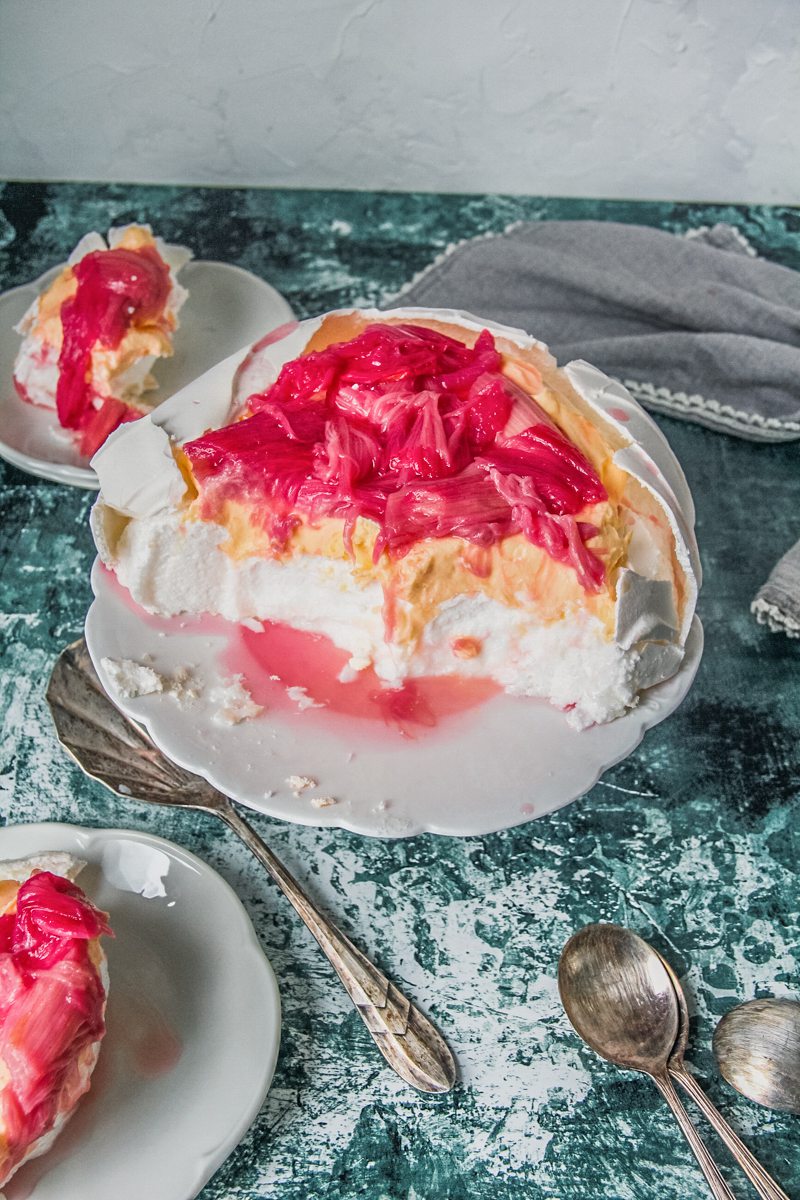
How to make Pavlova with Custard and Rhubarb:
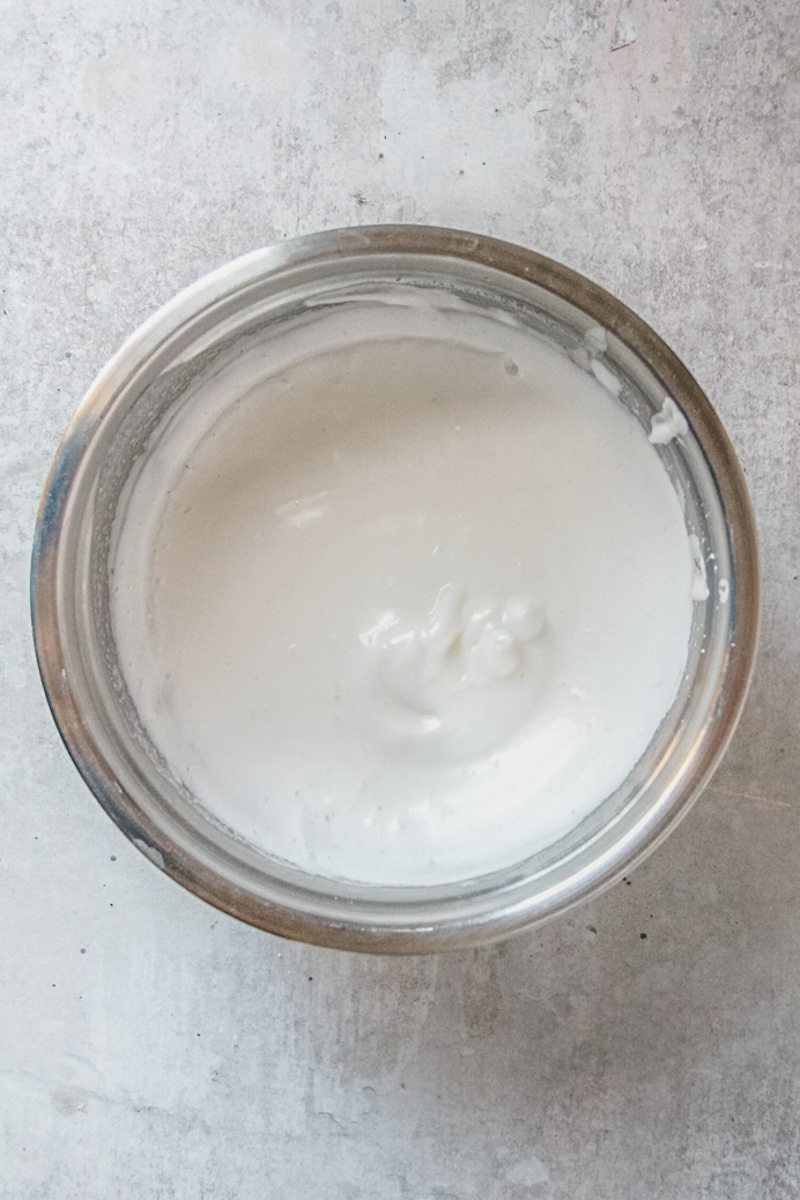
Step 1: Whip it: Whip the sugar, boiling water, vinegar, vanilla extract and egg whites in a clean bowl until stiff.

Step 2: Spoon and shape: Spoon onto a lined tray and shape carefully into whichever pavlova shape you prefer with an offset spatula or the back of a spoon.
Step 3: Bake: For 30 minutes before lowering the temperature and baking a further 30 minutes. Allow to cool completely in the oven.

Step 4: Rhubarb: Heat the rhubarb, sugar and orange peel on low heat until soft, but still holds it's shape.

Step 5: Custard: Sieve the sugar and custard powder then add the mascarpone and heavy cream and whisk until smooth and combined.

Step 6: Spoon: The custard into the center of the pavlova and carefully top with the rhubarb and a little of the juice.
Step 7: Serve immediately: Dig in!
FAQ's for the best Pavlova with Custard and Rhubarb
Yes! Room temperature egg whites absorb air more quickly to develop a nice and stable foam - though to really stabilize that foam we’ll need an acidic element (the vinegar we use here).
The best result in a stable but volumized meringue is to whip it at a low, but medium speed of around 3 (depending on your beaters), this will result in introducing enough air to expand the egg whites without over whipping when you begin to introduce your sugar.
Yes you can! Over whipping egg whites can result in your meringue collapsing or weeping beads of sugar once baked. The best way to avoid over beating is to ensure you beat at a steady speed and allow at least 20-30 seconds of beating time for the sugar to dissolve between adding more. Try not to beat for longer than 15 minutes (this is around the break point, I’ve noticed). Unfortunately, you cannot repair over whipped meringue, though, dependent on how over whipped they are, you could make an egg white based recipe such as macaroon’s or even a baked Alaska.
The length of time depends on if you’re introducing the sugar when you begin beating the egg whites or if you beat the egg whites to soft peaks and then begin adding the sugar in stages. Allow at least 20-30 seconds for the sugar to dissolve before adding more. You don’t want to beat the meringue for longer than 15 minutes to avoid over whipping.
You ultimately want to bake your pavlova at two different temperatures. Starting the baking at a higher temperature helps create the firm crust in your meringue and ensures less seepage and baking at a second and lower temperature helps bake the center creating the marshmallow texture.
Simply stenciling the shape you want for your pavlova onto the underside of your baking paper will help give you an easy border to work with. And the back of a spoon or offset spatula will help you create your desired shape.
It can indeed...in fact, it's best made 1 day ahead of serving, though will also be great to serve up to 3 days after baking. Simply store the plain pavlova in a dry container before topping with your cream and fruit. Once the cream is placed on top, it should be consumed with 3 hours. Full disclosure though, if you have leftovers after serving, you can refrigerate and it will be still good enough to eat the next day (we don't waste leftovers in our house).
More meringue recipes you'll love

Pavlova with Custard and Rhubarb
Ingredients
Pavlova
- 114 grams / 3 large or 5 small egg whites room temperature
- 200 grams / 1 cup superfine/caster sugar
- 30 grams / 2 tablespoons boiling water
- 5 grams / 1 teaspoon vinegar
- 1 teaspoon vanilla extract
Custard
- 25 grams / ¼ cup confectioner's/icing sugar
- 25 grams / 2 ½ tablespoons custard powder
- 150 grams / 5.3 ounces mascarpone
- 60 grams / ¼ cup heavy cream
Rhubarb
- 200 grams / 3 stalks rhubarb ends removed and sliced into 1 ½ inch pieces
- 25 grams / 2 tablespoons superfine/caster sugar
- 1 inch orange peel
Instructions
Pavlova
- Preheat the oven to 140ºC/280F and line a baking tray with greaseproof paper.
- Place the sugar, boiling water, vinegar, vanilla extract and egg whites in a clean bowl and beat on medium until the meringue is stiff and holds its shape when you pull the beater away, this will take 12 minutes.
- Spoon the meringue onto your greased tray and shape carefully into whichever pavlova shape you prefer with an offset spatula or the back of a spoon.
- Place in the oven and bake for 30 minutes before turning the temperature down to 120ºC/265F and bake for a further 30 minutes.
- Turn the oven off and allow to cool completely, minimum 2 hours before removing.
Rhubarb
- Meanwhile, place the rhubarb, sugar and orange peel in a saucepan on low heat and cook, covered until the rhubarb is soft, but still holding it's shape, approximately 10 minutes.
- Allow to cool completely.
Custard
- Sift the sugar and custard powder into a bowl then add the mascarpone and heavy cream and stir.
- Add in the mascarpone and heavy cream and whisk until smooth and combined.
- Spoon the custard into the center of the pavlova and carefully top with the rhubarb and a little of the sauce.
- Serve immediately.
Notes
- Egg whites: Room temperature fresh egg whites are best for a great pavlova as they are less likely to collapse.
- Sugar: Superfine or caster sugar will dissolve easily in our meringue and add sweetness without additional flavor. You could replace with white sugar. It is not recommended to substitute with brown sugar due to the flavor it will add to the pavlova.
- Vinegar: Vinegar strengthens the egg white structure helping stabilize and ensure the there is no seepage.
- Boiling water: The boiling water helps raise the temperature in the egg white mixture which makes this meringue closest to a Swiss Meringue helping make our meringue denser in texture than a French meringue and less fussy than an Italian meringue.
- Mascarpone: Mascarpone uses full fat cream as a base as opposed to cream cheese which has a full fat milk base. This makes it richer, softer and creamier, though slightly sweeter than cream cheese. You could replace the mascarpone with cream cheese here or replace entirely with a store-bought thick custard. The perfect texture for this mascarpone custard is that it has a texture like buttercream without the effort of whipping.
- Orange peel: The oils in the citrus peel add a depth of flavor to the rhubarb that help compliment the produce, custard and pavlova.
- Only use room temperature egg whites: They absorb air more quickly to develop a nice and stable foam - though to really stabilize that foam we’ll need an acidic element (the vinegar we use here).
- Shaping your Pavlova: Simply stenciling the shape you want for your pavlova onto the underside of your baking paper will help give you an easy border to work with. And the back of a spoon or offset spatula will help you create your desired shape.
- Try not to overbeat your meringue: Over whipping egg whites can result in your meringue collapsing or weeping beads of sugar once baked. The best way to avoid over beating is to ensure you beat at a steady speed and allow at least 20-30 seconds of beating time for the sugar to dissolve between adding more. Try not to beat for longer than 15 minutes (this is around the break point, I’ve noticed). Unfortunately, you cannot repair over whipped meringue, though, dependent on how over whipped they are, you could make an egg white based recipe such as macaroon’s or even a baked Alaska.
Nutrition
Subscribe to receive a free weekly newsletter using seasonal produce as well as exclusive content!
Made it and loved it?
If you have made this recipe, it would mean so much to leave a review below to help more people find this.


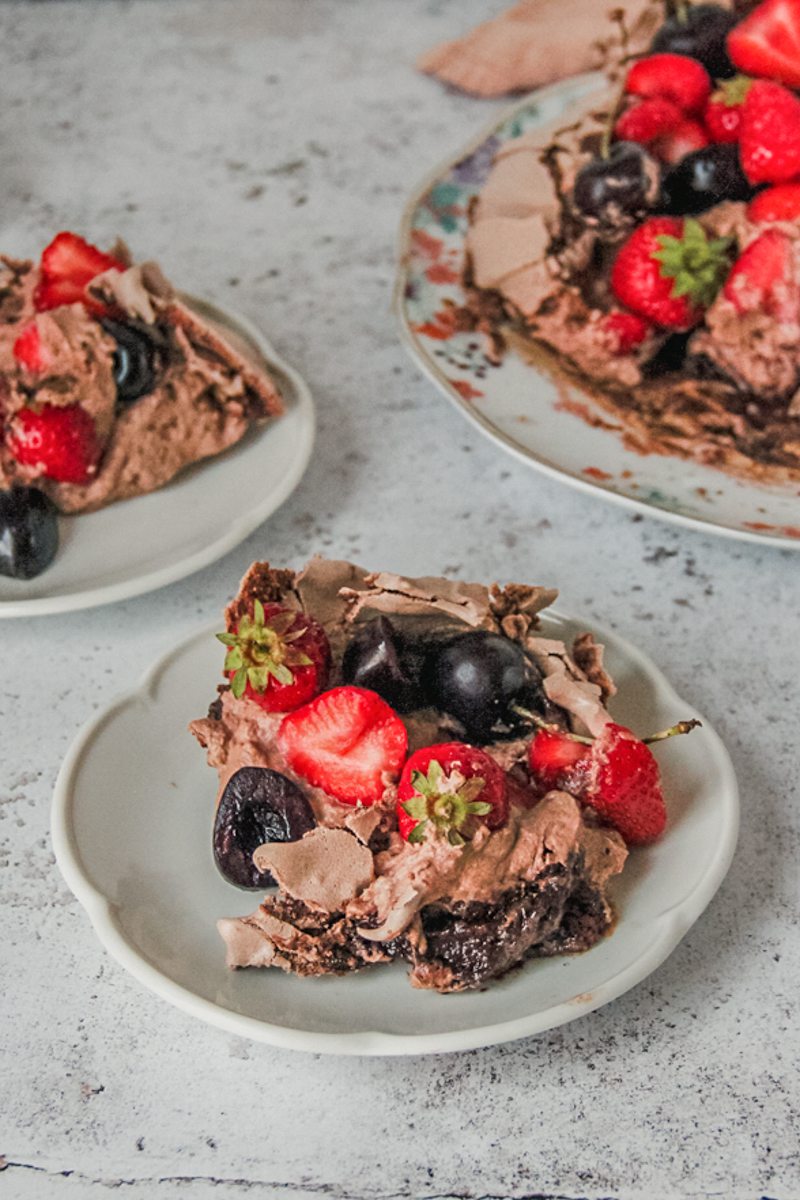
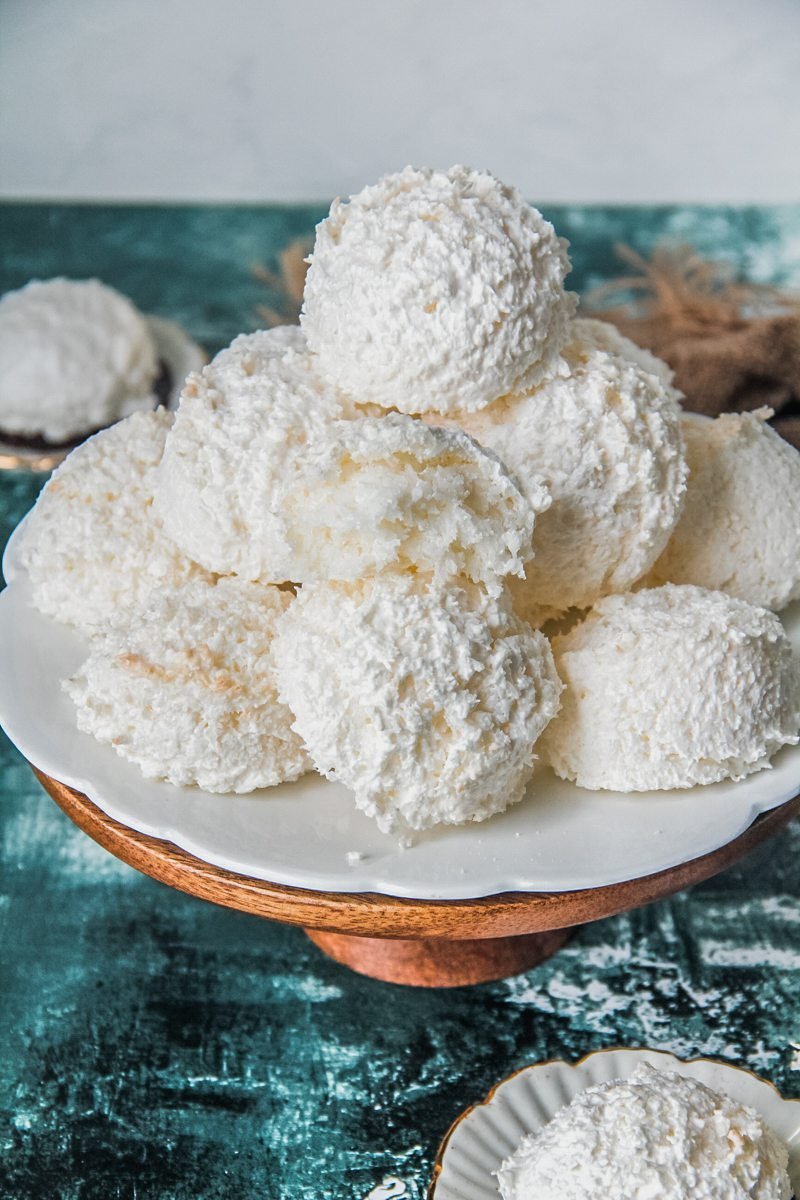


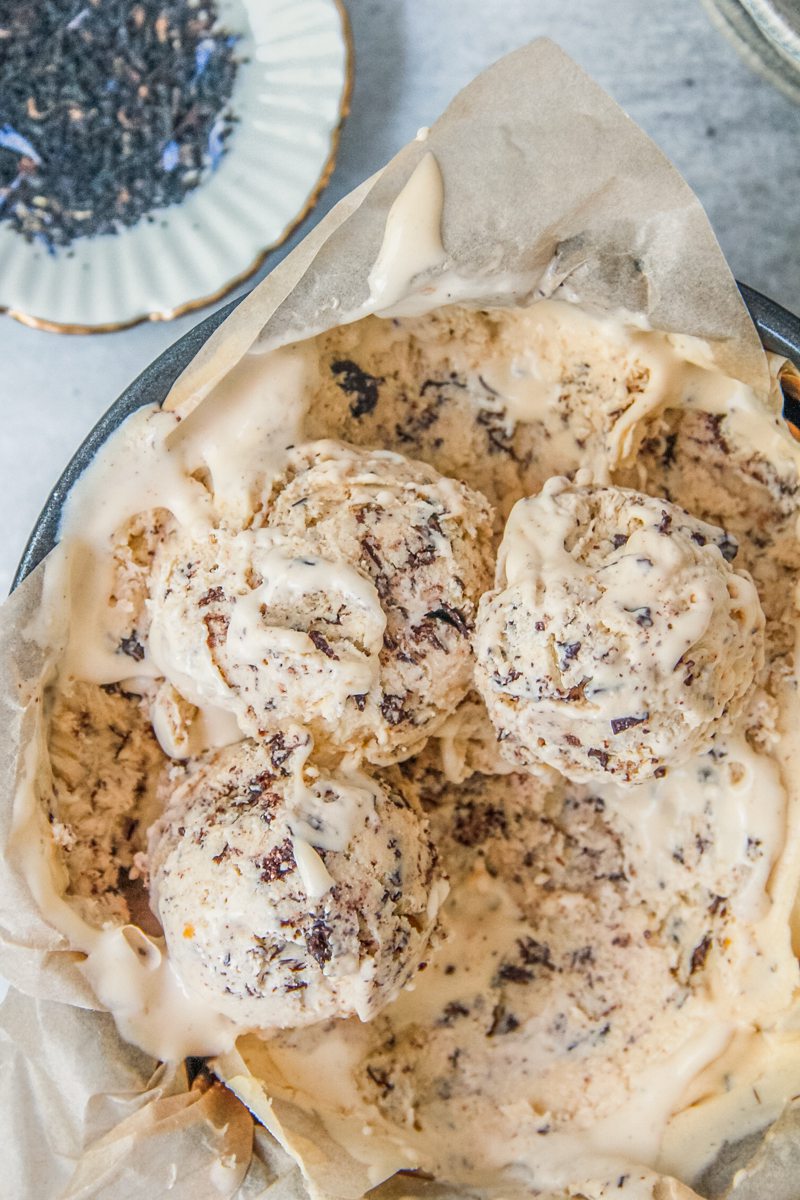
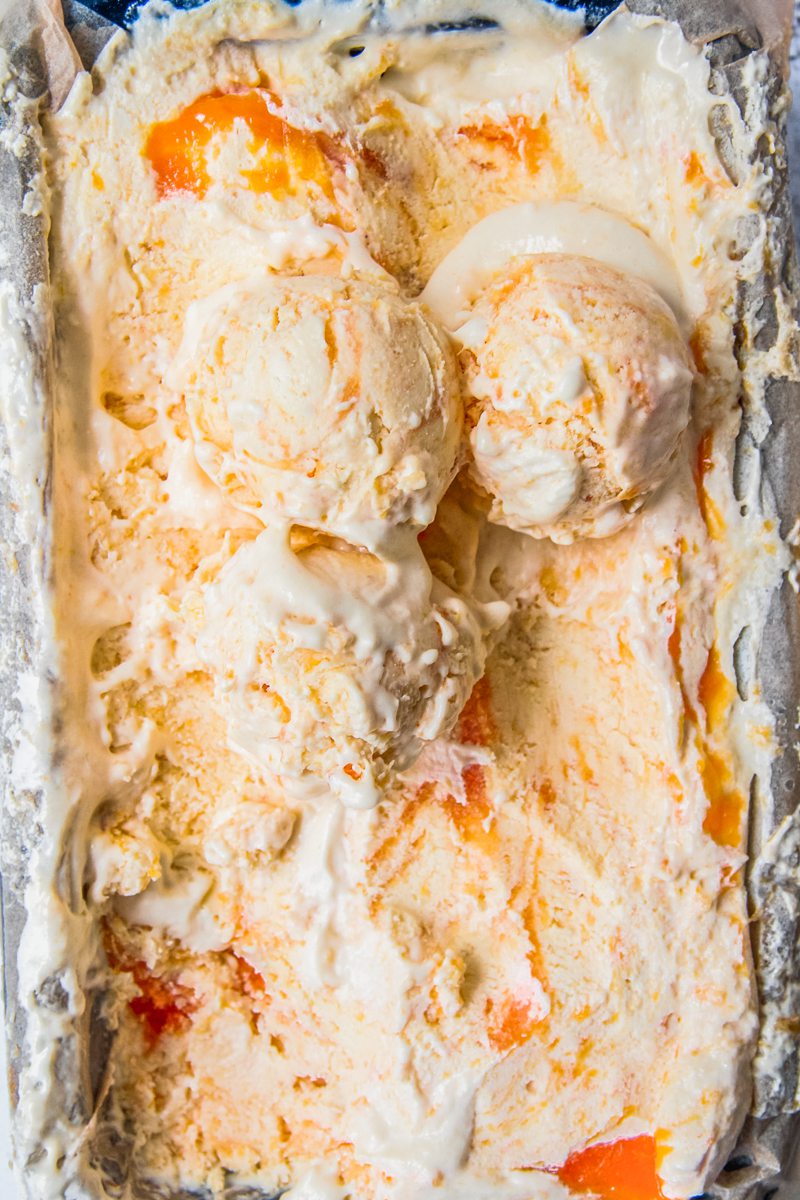

Leave a Reply